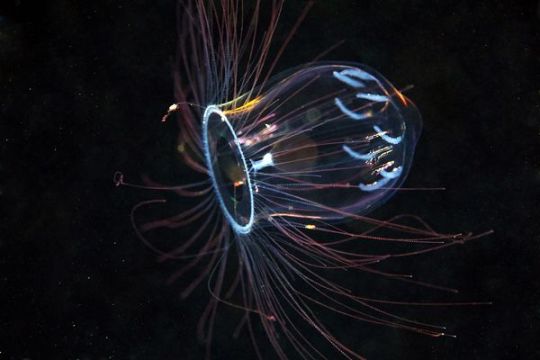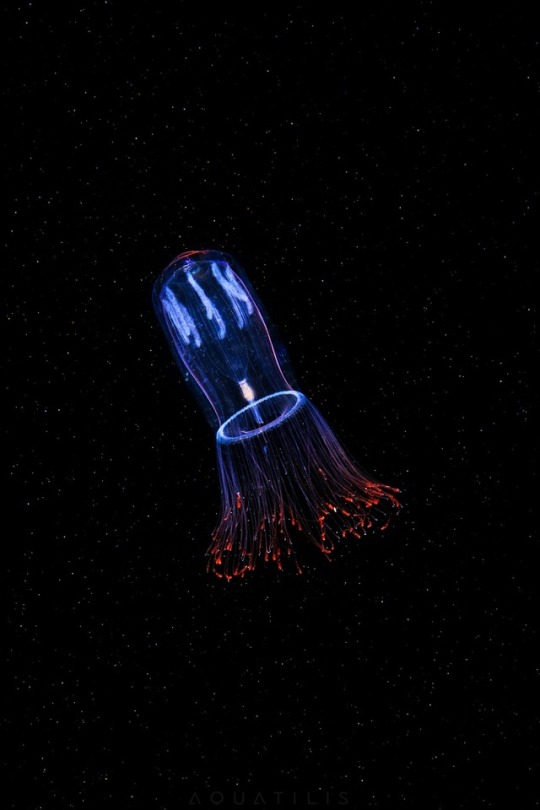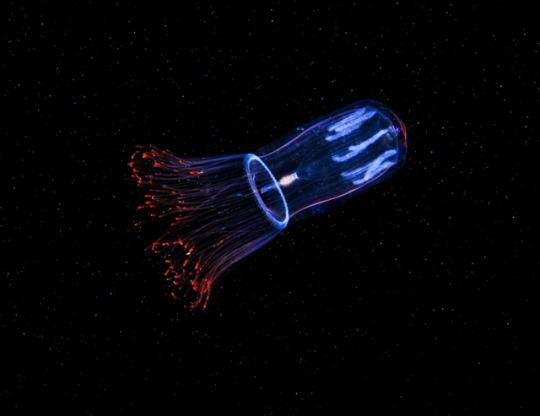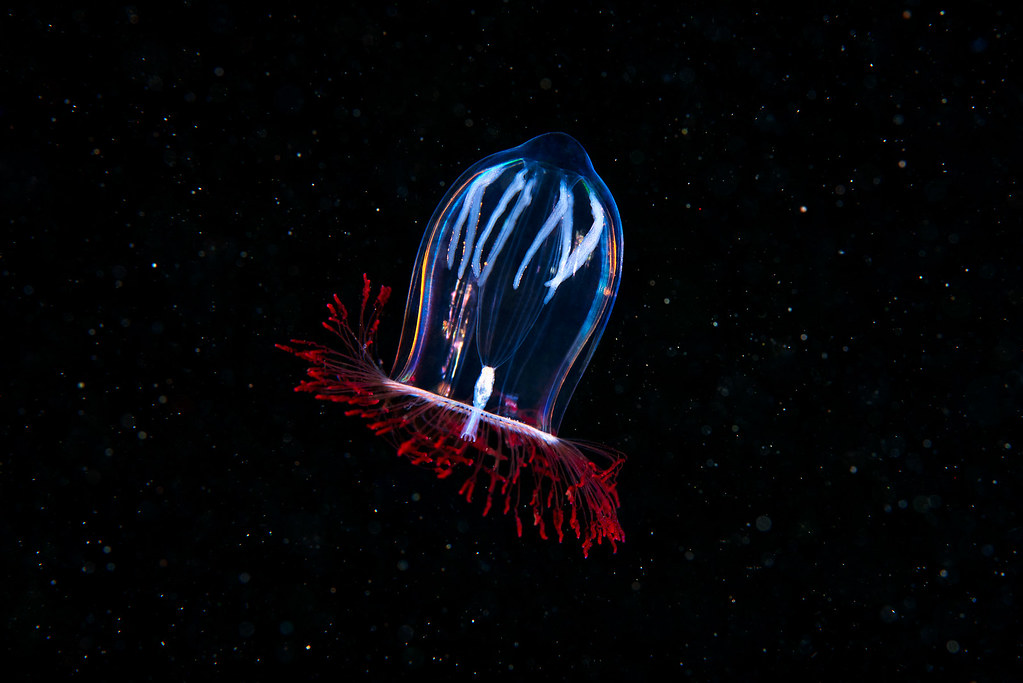#Aglantha
Note
hey excuse me. youre the jellyfish guy from the moon jelly stream yeah. one of my friends mentioned this and i was curious if it had any merit or whatever and i remembered i knew one (1) blog who might know that

Heyyy!! Sorry for being incredibly, incredibly late on this (University was hell but I mainly just used that as an excuse to not research neurobiology haha)
Now, to preface... I know nothing about the human brain. Neurobiology is boring and I want nothing to do with it.
But I do know the deal about jellyfish neurobiology... at least a little bit.
Anyways, jellyfish in general do not have brains or any sort of centralized nervous system (with the exception of Salps and other tunicates, which posses a primitive ganglia. Eugh. Chordates).
They are known, for the most part, to have a diffuse "nerve net" (the actual application of this really depends on the species though). It's the simplest form of a nervous system we have here in the animal kingdom.
Calling a diffuse nerve net a "brain" is a little suspect to me personally... mostly because our brain is literally just a flub of fat and muscles and would pretty much be useless if it weren't for the organs it has control over.
If I were to put it in simpler terms, brains are like the executive committee for a large company, as opposed to a nerve net, which works closer to like, a few high school friends that run your local McDonald's.
Like, that McDonald's can get stuff done, sure, but it's nowhere near as efficient as that large company.
Anyways, with that out of the way, I do want to at least get a little ramble about jellyfish nervous systems :). It won't make much sense but I'll try my best, haha.
I'm sure if anyone here has been following me long enough, they'll know that (cnidarian) Jellyfish are divided up into three distinct groups: Hydrozoa, Scyphozoa, and Cubozoa. The nervous systems of the three vary wildly by complexity, so I'll just start rambling about them by least to most complex.
Hydrozoans:
Hydrozoans are actually a sort of a mixed bag.
Some have nerve nets, while others have nerve rings (like the Aglantha digitale).
Nerve nets are basically just scattered nerves (though they tend to gather around important sensory organs) while nerve rings are ring-shaped gatherings of neurons. These run around the bell margin, and process sensory inputs like light, gravity, and touch.
The A. digitale uses these to have two different "swimming" modes (something about one nerve ring being able to generate drastic chemical spikes while the other one can only make gentle chemical spikes to create movement). Honestly you should probably just do the recommended reading below, it'll make more sense.
Scyphozoans:
GOD, now we're getting to the good part. Unlike hydrozoans, Scyphozoans have rhopalia, which contain the light sensing organ, the balancing organ, and pacemaker neurons (basically controlling the gentle pulsation of the bell).
As for the nerve nets, they have two types: Motor and Diffuse nerve nets.
Motor nerve nets, to no one's surprise, control movement as a whole (which are ultimately controlled by rhopaliar pacemakers), while diffuse nerve nets mostly serve to advise the motor nerve nets on changing conditions (I have no idea what this means but it seems to play more of a support role when it comes to the animal)
Cubozoa:
We've all heard of them. How sophisticated they are and all the delicious behaviours they're able to irk out of their tiny, brainless bodies.
Like Scyphozoans, they have a diffuse nerve net and rhopalia- though that's about where all the similarities end.
Box jellyfish have true eyes, which are proven to see colour and form images (and box jellyfish seem to have targeted behaviours, like hunting). You know, some box jellyfish, like the Chironex fleckeri (sea wasp) and Morbakka virulenta (Hikurage) are known to "tuck" in their tentacles when not actively hunting? I think that's pretty cool. The Copula sivickis (herpes jellyfish) are also known to um. Have sex. Yeah idk how to make it sound any less awkward.
Anyways, it appears that their nervous system is the most sophisticated, but it largely centers around the Rhopalia (I've seen it being referred to as the "Rhopalial Nervous System" or RNS lol). There's even a ring nerve (not Nerve Ring) that connects the rhopalia, which integrates the swim, visual, and tentacle systems as well.
This is the shortest explanation from the article I'm gleaning this off of, but there are countless research papers that study the cubozoan nervous system.
Recommended Reading:
Unfortunately, I'm not the best person to go to to get your Jellyfish Neurology fix (or really any sort of neurology fix at all), but I did find some wonderful resources for anyone who's interested in learning more (NOTE: Very dense and uses very specific terminology, may be difficult to understand):
Jellyfish Nervous Systems (Current Biology Vol 23 No 14), a more condensed PDF version of of this article. It's a really good crash course on Jellyfish neurobiology- and if you skim past the dense biology-ese, then you can actually learn some cool stuff about jellyfish ^-^
Do jellyfish have central nervous systems? (The Journal of Experimental Biology Vol 214 Issue 8), goes pretty in depth about how different jellyfish nervous systems work, including actual studies and many more images. I haven't finished reading it but it looks interesting :>
Diffuse nervous systems (Britannica), a good overview of nervous systems as a whole. It is very in depth on the different sorts of nervous systems in the animal kingdom and kind of did the legwork for me in the beginning ramble.
From From nerve net to nerve ring, nerve cord and brain — evolution of the nervous system (nature.com), basically what Britannica did but moreso through the lens of how nervous systems evolved over the times. I didn't read through it very much, but I wanted to learn more about nerve rings so here we are.
#ow this hurt my brain lol#I've always been pretty confident that I could learn anything if it had to do with jellyfish but ironically learning about nervous systems-#-has been overloading /my/ nervous system (brain) <3#mun rambles#jellyfish#long post#ask#hopefully this wasn't too confusing haha ;w;. i'd be lying if I said I wasn't confused myself#well. it was fun though. I love talking about jellyfish behaviours#thanks for asking :>
18 notes
·
View notes
Photo


Pink Helmet
Aglantha digitale
The Pink Helmet is a mini hydromedusa that comes in a variety of vibrant colors. The tiny jelly is only 4 cm in size and is found towards the surface of the ocean. The purple and blue hues we see in its bell are caused by a phenomenon known as iridescence, when light strikes the jelly’s thin tissue at different angles (similar to what we see in a soap bubbles). It also has orange pigmentation near its mouth; this pigmentation helps attract prey and mask luminescence. Furthermore, females tend to be more colorful than males.
Photo credit: https://biolum.eemb.ucsb.edu/organism/pictures/aglantha.html
https://www.pinterest.com/pin/186899453255850798/
#invertebrates#jellyfish#hydromedusa#biology#deep ocean#plankton#holoplankton#pink helmet#Aglantha#nature#bioluminescence#marine biology#oceanlife#planet earth#marine life#the blue planet#marine#marine animals#glowing in the dark#education#marine science#science#ocean#ocean lover#knowledge#not mine#knowledge is power#sea#sea life#sea creature
3K notes
·
View notes
Video
Alexander Semenov
6 notes
·
View notes
Text

Aglantha digitale
28 notes
·
View notes
Video
Aglantha digitale - Pink helmet jellyfish by Alexander Semenov
0 notes
Photo

Aglantha digitale - Pink helmet jellyfish
by Alexander Semenov
706 notes
·
View notes


